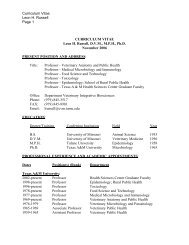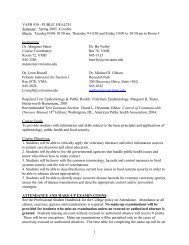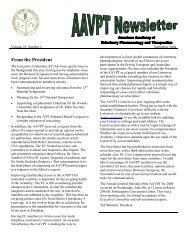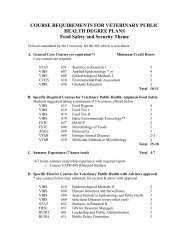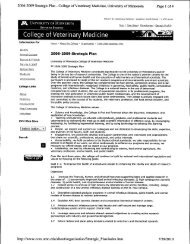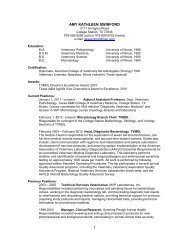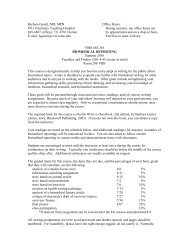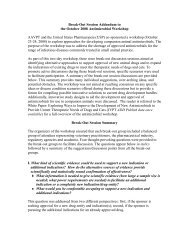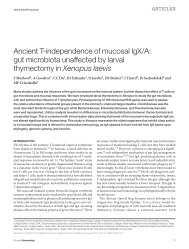Disaster - College of Veterinary Medicine - Texas A&M University
Disaster - College of Veterinary Medicine - Texas A&M University
Disaster - College of Veterinary Medicine - Texas A&M University
Create successful ePaper yourself
Turn your PDF publications into a flip-book with our unique Google optimized e-Paper software.
was using some their most valuable team members—their<br />
dogs—to assist in the search and rescue effort. The TAMU<br />
VETs were able to respond and test their ability to deploy<br />
with equipment and operate in the field.<br />
“Overall, the drill went exceedingly well,” said Bissett. “We<br />
sent teams out with specific routes to simulate assessment activity<br />
and also conducted a triage exercise. We were also able<br />
to identify holes and rough spots in our process and plans<br />
so that they could be ironed out prior to the beginning <strong>of</strong><br />
hurricane season.”<br />
Representatives from the Department <strong>of</strong> Homeland Security<br />
attended the exercise as guests <strong>of</strong> TTF-1. Impressed with<br />
what they saw from TAMU VETs, they asked a lot <strong>of</strong> questions<br />
<strong>of</strong> the team. There is interest in potentially pursuing<br />
the TAMU VET program as a national model.<br />
Dr. J. Jill Heatley, clinical associate pr<strong>of</strong>essor at<br />
the <strong>Texas</strong> A&M <strong>College</strong> <strong>of</strong> <strong>Veterinary</strong> <strong>Medicine</strong> &<br />
Biomedical Sciences (CVM), has taken a leading<br />
role in the recent efforts to help animals affected<br />
by the oil spill in the Gulf.<br />
While Heatley teaches a Zoo and Exotic <strong>Medicine</strong><br />
class at the CVM, she has also spent the past<br />
seven months teaching training classes at the<br />
Wildlife Rehabilitation and Education Center<br />
(WREC) in Houston. The WREC’s Oiled Wildlife<br />
Response Team is on call 24/7 and is currently<br />
on standby to respond to any and all wildlife<br />
impacted by the oil slick caused by the fire and<br />
sinking <strong>of</strong> the drilling platform Deepwater<br />
Horizon.<br />
“Even though we do have the occasional veterinary<br />
student take our classes, we are open to<br />
the public, so we mostly teach oil field workers,<br />
public safety <strong>of</strong>ficials, public health workers, and<br />
really anyone whose job crosses paths with the<br />
oil spill,” said Heatley.<br />
She explains that all different species <strong>of</strong> animals<br />
have been affected by this disaster including<br />
birds, fish, sea turtles, mammals, otters, etc.<br />
with the exception <strong>of</strong> sea otters which are not<br />
found on this part <strong>of</strong> the coast.<br />
“The animals most visible to the human eye<br />
are birds, so our main focus is teaching recovery<br />
procedures for them. Part <strong>of</strong> what we teach our<br />
students is how to take care <strong>of</strong> the animal within<br />
the first critical 24 hours. Also, how to correctly<br />
handle and properly clean affected animals,”<br />
said Heatley.<br />
To work with oil affected animals one must<br />
be certified and trained, therefore a civilian<br />
who comes into contact with such an animal<br />
should contact a wild animal control <strong>of</strong>ficer<br />
immediately.<br />
“We think we have a good set up and a great plan,” notes<br />
Bissett. “Moving forward, we intend to pursue additional<br />
funding to better equip our teams to provide all-species,<br />
all-hazard response. We hope that in the future, we will be<br />
able to establish a national center for emergency response<br />
training for veterinarians, and potentially others interested<br />
in emergency response, right here at the CVM.”<br />
With minimizing animal suffering as the primary directive,<br />
the TAMU VETs are able to use their expertise and<br />
equipment to make an impact on human health and the<br />
health <strong>of</strong> the environment as well by helping a disasterstricken<br />
area move more quickly towards recovery through<br />
effective assessment, triage, and teamwork.<br />
Caring for the animals affected by the<br />
Gulf Oil Spill<br />
CVM Today • Summer 2010 • 23




